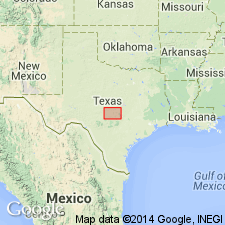
- Usage in publication:
-
- Coleman bed
- Modifications:
-
- Original reference
- Dominant lithology:
-
- Clay
- Limestone
- Shale
- AAPG geologic province:
-
- Bend arch
Summary:
Pg. 421, 424. Coleman bed in Albany division [Wichita group]. To south mostly marly yellowish clay with some thin beds of limestone. To north chiefly black or dark-gray sandy clay shale with many white specks scattered through it. Thickness 50 to 100 feet. Member of Albany division [Wichita group]. Overlies bed No. 5 (25 to 60 feet of limestone with some marly clay) and underlies Elm Creek bed. Age is possibly Permian.
[Named from Coleman, Coleman Co., Colorado River region, central TX.] Most of town is built on the outcrop.
Source: Publication; US geologic names lexicon (USGS Bull. 896, p. 487).

- Usage in publication:
-
- Coleman clay
- Coleman limestone
- Modifications:
-
- Revised
- AAPG geologic province:
-
- Bend arch
Summary:
Pg. 193, pl. 11. Divided their Admiral formation (basal formation of Wichita group) into (descending): Elm Creek limestone, 20 to 50 feet; "Coleman clay" (Drake), 148 feet; Coleman limestone, 12 feet; "Bed No. 5" of Drake, 3 feet; Indian Creek shale, 105 feet; Hordes Creek limestone, 2 feet; Lost Creek shale, 46 feet. They defined "Coleman clay" as consisting of (descending) grayish yellow shale, 22 feet; yellow-gray limestone, 2 feet; black shale, 34 feet; muddy brown limestone, 1 foot; dark-gray shale, 17 feet; gray limestone, 1 foot; shale, 11 feet; sandy shale, 3 feet; shale, 58 feet; and defined Coleman limestone as consisting of 3 feet of yellow gray limestone underlain by 9 feet of yellow shale. Age is Permian.
Source: US geologic names lexicon (USGS Bull. 896, p. 487).
For more information, please contact Nancy Stamm, Geologic Names Committee Secretary.
Asterisk (*) indicates published by U.S. Geological Survey authors.
"No current usage" (†) implies that a name has been abandoned or has fallen into disuse. Former usage and, if known, replacement name given in parentheses ( ).
Slash (/) indicates name conflicts with nomenclatural guidelines (CSN, 1933; ACSN, 1961, 1970; NACSN, 1983, 2005, 2021). May be explained within brackets ([ ]).

